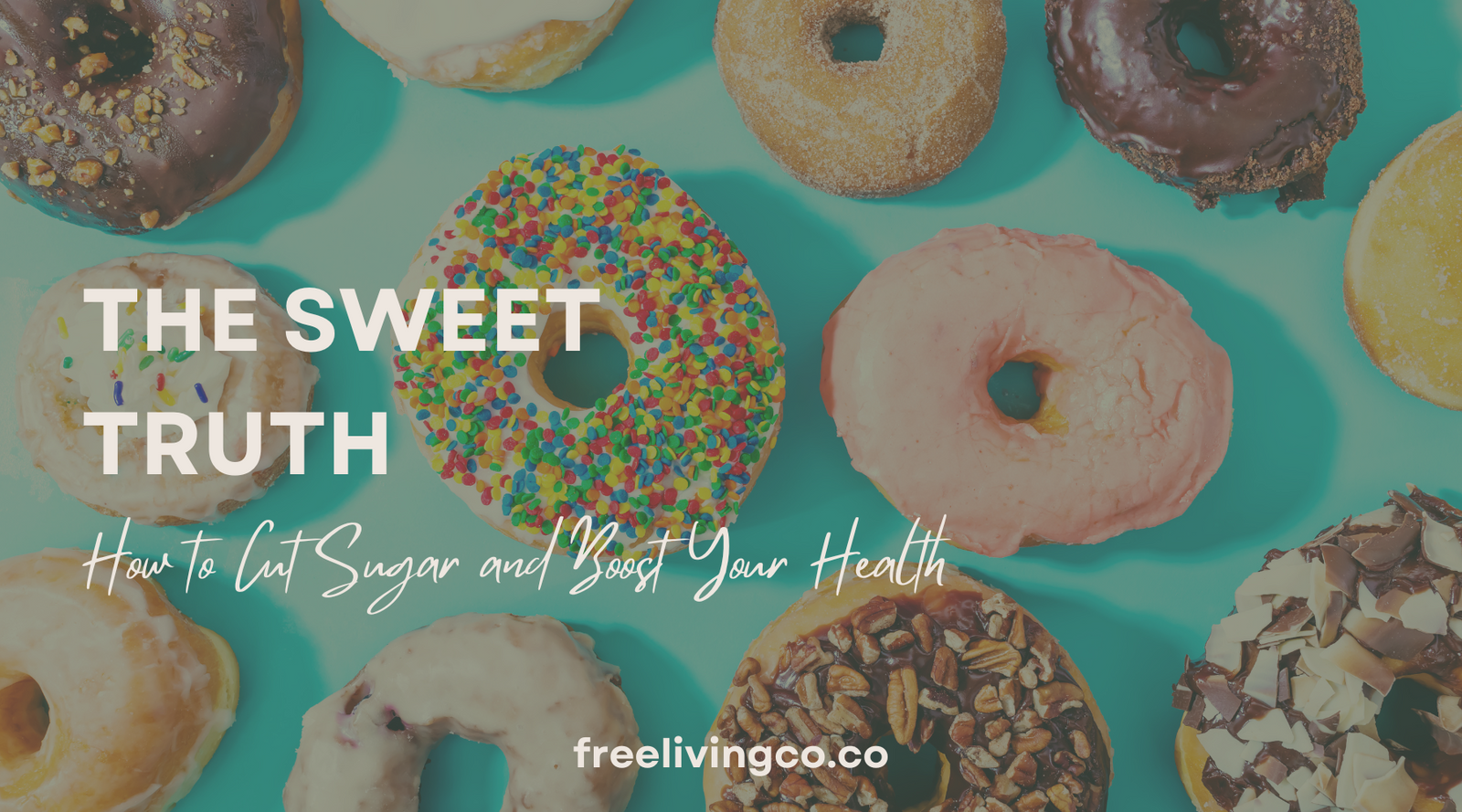The Sweet Truth: How to Cut Sugar and Boost Your Health

On average, Americans consume about 17 teaspoons of added sugar every day—that’s 2 to 3 times the recommended daily limit (source).
While sugar may taste sweet, its impact on health is anything but. Research has linked excess sugar intake to:
- Obesity
- Type 2 diabetes and other chronic diseases
- Non-alcoholic fatty liver disease
- Metabolic syndrome
- Chronic inflammation
- Dementia
- Gut health issues
- Depression
- Acne
Not only does sugar taste addictive, but it also has addictive properties. It stimulates the brain’s reward system in a way similar to recreational drugs. When you eat sugar, your brain releases opioids and dopamine—neurotransmitters that generate feelings of pleasure and reward. This “sugar high” reinforces cravings, creating a cycle of overconsumption that’s difficult to break
But there’s good news! You can regain control of your sugar intake and I’ll show you how!
Here’s what we’ll cover:
- Understanding Sources of Sugar (naturally vs. added)
- Practical tips for reducing sugar consumption
- My favorite sugar swaps to keep cravings in check
Understanding Sources of Sugar
Has someone ever told you that fruit is equivalent to a candy bar? Let’s clear this up! Naturally occurring sugars are found in whole foods like fruits, vegetables, dairy, and grains. For example, fruit contains fructose, which is naturally packaged with fiber. This fiber slows digestion and absorption, preventing a blood sugar spike and supporting metabolic health. Additionally, whole foods provide essential nutrients like vitamins and minerals, making them an important part of a balanced diet. So fruit is NOT equal to a candy bar!
On the other side we have added or free sugars. These sugars are extracted from their natural sources and used to sweeten foods or extend shelf life. Examples include high fructose corn syrup and fruit juice concentrates. Unlike natural sugars, they lack nutrients, cause rapid blood sugar spikes, and contribute to energy crashes and long-term health issues.
Then, of course, we have alternative sweeteners, which I like to break down into two categories: natural and artificial.
- Natural options: Stevia, monk fruit, honey, molasses, and coconut sugar are less processed and derived from natural sources. Use these in moderation.
- Artificial options: Sucralose, aspartame, and saccharin can harm gut health, increase glucose intolerance, and potentially become more addictive.
Reducing overall sweetener intake helps improve sensitivity to the natural sweetness of whole foods.
Tips for Label Reading:
- Check for "added sugar" on labels—aim for products with 5 grams or less per 100 grams.
- Limit sugar intake to 6 teaspoons daily (ideally less).
- Scan ingredients for hidden sugar terms like cane juice, corn syrup, and dextrose.
The less processed and more natural the sweetener, the better—but moderation is key!
Practical tips for reducing sugar consumption
Tip 1: Start with protein-packed meals!
Protein is key to help stabilize blood sugar levels and reduce cravings. By increasing protein you also tend to stay fuller longer, helping reduce sugary snacks.
Aim to include protein at every meal—think eggs, meats, fish, legumes, dairy, tofu or protein powders.. When building a plate ideally ½ the plate is veggies, ¼ starchy carbs, and remainder is protein.
I always encourage starting your morning strong with a high-protein breakfast, such as a veggie omelet, Greek yogurt with nuts, or a protein smoothie. This sets a stable blood sugar foundation for the day. Aim for 25-35 grams of protein at breakfast.
Tip 2: Add more fiber
Fiber helps slow down the absorption of sugar and supports a balanced gut microbiome It also helps reduce sugar cravings by promoting satiety and keeping you fuller longer. Include fiber-rich vegetables, whole grains, nuts, seeds, and fruits in your meals. Opt for complex carbohydrates like sweet potatoes, quinoa, or oats. Try to reach 25–30 grams of fiber per day from whole food sources, adding gradually if you're not used to high-fiber intake.
Tip 3: Walk after Meals
I always recommend taking a walk after meals. Even a short 5–15 minute stroll can significantly improve your blood sugar response and glucose uptake, helping to stabilize blood sugar levels, prevent “sugar crashes,” and reduce cravings. Over time, you can work up to longer walks if desired. If you’re short on time, try using a standing desk or pacing while on calls to keep your body moving throughout the day. Small changes like these can make a big difference!
Tip 4: Get Plenty of Sleep
Sleep is foundational to overall health! Poor sleep disrupts hunger hormones and increases cortisol, which can lead to heightened sugar cravings. Aim for 7–9 hours of quality sleep nightly by establishing a calming bedtime routine. Minimize screen exposure before bed, and consider unwinding with a caffeine-free tea like chamomile or peppermint to promote relaxation. Optimize your sleep environment by keeping it dark, cool, and quiet for the best results. Small adjustments to your sleep habits can have a big impact on your energy and cravings!
My favorite sugar swaps to keep cravings in check
When reducing sugar intake, I recommend choosing naturally sweetened options like honey, real maple syrup, dates, and fruit. Keep prepared snacks on hand, such as fresh or dried fruit (without added sugar) and homemade trail mix.
Sweet Treat Swaps:
As a dietitian, I often talk to people about the challenges of reducing sugar intake. While it can be tricky, the benefits for your long-term health goals are worth it. By following the four tips above and trying simple swaps, you'll start seeing a reduction in cravings and sugar consumption in no time! These small changes can have a big impact on your overall health.
About the Author:
Elizabeth Arensberg is a gut health dietitian and owner of E. Arensberg Nutrition LLC. She helps individuals with digestive issues repair their gut so they can feel more energized, maintain healthy bowel movements, and experience less stress around food. Find her over on instagram @gratefulgut_nutirtion.






Leave a comment